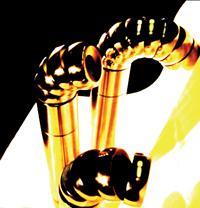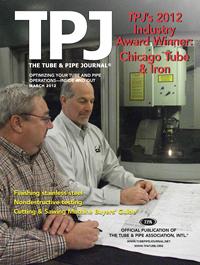- FMA
- The Fabricator
- FABTECH
- Canadian Metalworking
Categories
- Additive Manufacturing
- Aluminum Welding
- Arc Welding
- Assembly and Joining
- Automation and Robotics
- Bending and Forming
- Consumables
- Cutting and Weld Prep
- Electric Vehicles
- En Español
- Finishing
- Hydroforming
- Laser Cutting
- Laser Welding
- Machining
- Manufacturing Software
- Materials Handling
- Metals/Materials
- Oxyfuel Cutting
- Plasma Cutting
- Power Tools
- Punching and Other Holemaking
- Roll Forming
- Safety
- Sawing
- Shearing
- Shop Management
- Testing and Measuring
- Tube and Pipe Fabrication
- Tube and Pipe Production
- Waterjet Cutting
Industry Directory
Webcasts
Podcasts
FAB 40
Advertise
Subscribe
Account Login
Search
Material selection for rotary draw bend tooling
Choices abound in substrates, coatings, processes
- By Bob Want
- March 12, 2012
- Article
- Bending and Forming
When considering which tools used in rotary draw bending are high-wear consumables, you probably think of mandrels and wiper dies first. During the bending process, these tools are in a fixed position, under substantial load and pressure, which leads to considerable friction.
Of course, no two bends are alike. As the severity of the bend increases—larger OD, thinner wall, or tighter radius—the pressure exerted on the tools increases exponentially. Likewise, the interaction between tooling and tubing varies from application to application. As the tubing material changes, the tooling material, lubricant, and lubrication system should change too.
Unfortunately, in many cases, especially high-production environments, a one-size-fits-all approach prevails. This is based on a common misconception: “If we use a soft material for the tools, they won’t scratch the tube, so it’s the best solution.” In a hectic workplace where some decisions are made to satisfy the production department but not the engineering or accounting departments, this effectively becomes, “If we use a soft material for the tools, they won’t scratch the tube, regardless of the material type, or even if the lubrication selection or quantity is inadequate, intermittent, or omitted altogether.”
Enter the old stand-by alloy, aluminum bronze. There is no question that this material works for wipers and mandrels, and in fact is preferred for forming tubular components made from titanium and nickel alloys, but it rarely is the most cost-effective material.
This material does have additional advantages. For example, it requires no postmachining heat treating, which cuts the time needed to get replacement tools. On the other hand, the raw material cost fluctuates wildly, which affects profit margins, and aluminum bronze mandrels are usually unsalvageable after wear makes them too undersized to support the tube.
Are Heat-treated Tools Better or Brittler?
A harder material that will hold up longer is potentially a better choice, especially hardened steel plated with an appropriate coating. Among the more common coatings used for bending tube are titanium nitride (TiN) and titanium carbon nitride (TiCN). A drawback common to both materials is that several aspects of their manufacture add cost and time.
For example, generally the best base material for proper adhesion is D2 tool steel. The raw material is machined and heat-treated to RC 68-70 (Vickers 1076), the OD is ground and polished, then the tooling is coated. It is not uncommon for an average-size, multiball mandrel with TiN coating to require five weeks to make. A tooling failure can be devastating in a high-production shop if no backup tool is available. This is compounded by this tool’s higher potential for breakage; the heat-treating process, which increases the tool’s resistance to wear, also makes it more brittle.
Alternatives
In most cases, a simple solution is the best. A plating process known as industrial hard chrome, which uses hexavalent chromium, has been used for bending tooling almost since the advent of ball mandrels. Hard chrome should not be confused with decorative chrome, which is trivalent chromium.
Hard chrome, when properly applied, has a uniform thickness between 0.001 and 0.002 inch.
The Coating Process. Fabricators should be aware that many factors affect the chrome’s adhesion and finish. For a consistent, high-quality finish, the plater must practice good housekeeping and monitor the plating process continually, maintaining the correct chemical balance.

Figure 1: Figure 1 A photomicrograph of a bending tool plated with industrial hard chrome reveals a network of intersecting crevasses. The crevasses provide a surface to which the Teflon bonds and improve the tool’s ability to retain oil, increasing its lubricity. Photo courtesy of Dr. T.D. Ziebarth, Hauser Laboratory
The Substrate. Hard chrome can be applied to most types of steel, but it is pointless if the base metal is not hardened first. Industrial hard chrome has a hardness of RC 68-70 (Vickers 1076). A common base material is 8620 carburized to RC 48-54 (Vickers 513), which provides a strong base with good adhesion properties. Case-hardened steel also provides a suitable base for thin mandrel ball segments without the brittleness of fully hardened tool steel.
Because the plated surface is intended to be the wear surface, preserving the substrate, the tools can be stripped and replated numerous times if they are stripped and replated before the friction wears away the coating and starts to eat away at the base material, thereby changing the tool’s dimensions.
The downside to industrial hard chroming is that it’s a costly process. The plater invests in expensive equipment and must comply with strict government regulations that stipulate air quality and wastewater disposal. If you bring this responsibility in-house, you also take on substantial liability. The regulations are many, and the consequences of noncompliance are severe. Most fabricators elect to have this process done by a company that specializes in plating.
An Additive. Controlled cavitation of the coating creates a surface with increased porosity, which can improve lubricant retention. This process lends itself to a secondary operation which impregnates the chromium with Teflon® and uses heat to bond the two together (see Figure 1). The process is effective for bending many alloys, such as mild steel, aluminized 400-series stainless steel, and nickel alloys. Furthermore, it can be replated to increase the tool’s service life.
What About Lubrication?
All types of mandrels and wiper dies require proper lubrication, in type and amount. The correct lubrication increases the tooling’s functionality and longevity. This is a rule, and there are no exceptions—no material type, plating, or coating precludes the need for lubrication. Omitting lubrication sacrifices the tooling prematurely.
About the Author
Bob Want
194 W. Dakota Ave.
Denver, CO 80223
303-777-7170
About the Publication
Related Companies
subscribe now

The Tube and Pipe Journal became the first magazine dedicated to serving the metal tube and pipe industry in 1990. Today, it remains the only North American publication devoted to this industry, and it has become the most trusted source of information for tube and pipe professionals.
start your free subscription- Stay connected from anywhere

Easily access valuable industry resources now with full access to the digital edition of The Fabricator.

Easily access valuable industry resources now with full access to the digital edition of The Welder.

Easily access valuable industry resources now with full access to the digital edition of The Tube and Pipe Journal.
- Podcasting
- Podcast:
- The Fabricator Podcast
- Published:
- 04/16/2024
- Running Time:
- 63:29
In this episode of The Fabricator Podcast, Caleb Chamberlain, co-founder and CEO of OSH Cut, discusses his company’s...
- Trending Articles
Team Industries names director of advanced technology and manufacturing

Orbital tube welding webinar to be held April 23

Chain hoist offers 60-ft. remote control range

Push-feeding saw station cuts nonferrous metals

Corrosion-inhibiting coating can be peeled off after use

- Industry Events
16th Annual Safety Conference
- April 30 - May 1, 2024
- Elgin,
Pipe and Tube Conference
- May 21 - 22, 2024
- Omaha, NE
World-Class Roll Forming Workshop
- June 5 - 6, 2024
- Louisville, KY
Advanced Laser Application Workshop
- June 25 - 27, 2024
- Novi, MI



























